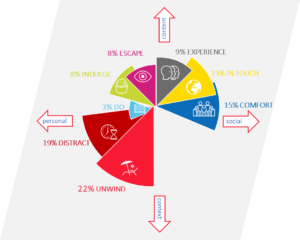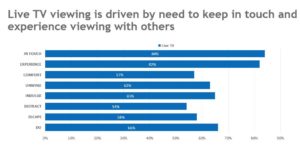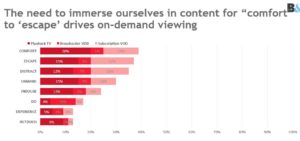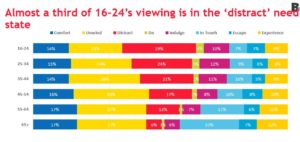Video is firmly entrenched in our lives. Whether we’re snuggling on the sofa for an evening of telly or killing time on our mobiles before the bus arrives, the opportunities to watch have never been greater.
Partnering with Thinkbox UK and with the Irish research carried out by Behaviour & Attitudes, we wanted to detangle the role that video plays in our lives to determine how the different video formats coexist and why viewers choose to invest their time in a range of video platforms.
The study found that our motivations can be categorised into eight different ‘need states’: unwind, distract, comfort, in touch, experience, indulge, escape and do.
The need states methodology
The Analysis for this research was in two parts.
- Firstly, Thinkbox UK recruited the research consultancy, MTM, to determine the fundamental needs that drive our video choices. To do this, thirty people were given camera glasses to enable them to capture their TV and video viewing in real-time. The camera glasses ensured that all viewing, regardless of location or screen, was recorded. This resulted in over 150 days’ worth of analysable footage. Once the task was completed, each respondent was interviewed at length about their viewing choices and the motivations behind what they watched.
- We then commissioned B&A to run an online survey of 1,000 adults to map the size of the trends in Ireland that we had observed in the first stage of the research.
Key questions we wanted to address included: What are the fundamental needs that drive our viewing choices and how do these needs differ for newer video platforms and forms of content? What role does context have in influencing our viewing choices? How do viewer needs and behaviours differ across age and life-stage? What needs are most likely to endure throughout different life-stages?
The Findings
The study found that our motivations can be categorised into eight different ‘need states’: unwind, distract, comfort, in touch, experience, indulge, escape and do. The size of each of the Needstates is dictated by the time audiences spend meeting each one with video content. A significant proportion of time spent watching video content is to fulfill the need to unwind, and for distraction.

The proliferation of content and ease of availability across platforms means that all forms of video coexist in harmony but each has now been liberated to do what it does best.
For TV, it’s about the high quality, immersive and trusted environment that the broadcasters offer. It’s about platforms that help the viewer relax, bring households together and connect countless viewers by providing a valued shared experience. TV takes up the vast majority of our viewing time and will continue to do so for the foreseeable precisely for these reasons.
SVOD has developed to provide a valued means of binge-watching and YouTube fills gaps in the day with short bites of video and is a go-to destination for practical help.
In short, the current video landscape offers a multitude of opportunity for viewers to fulfil all of their viewing needs.
Key Findings
1)Live TV delivers across the widest range of Needstates.
This study showed that live TV delivers across the widest range of need states, particularly in terms of helping people stay in touch, or spend time together. Live TV also excels at providing a mass shared viewing experience, with more than 80% of time spent in the experience need state being served by live TV

2) The Needs for “comfort and to “escape” drive Video on Demand viewing.
The proliferation of VOD services have enhanced TV’s ability to serve different needs. This is because entire series are available on demand through both the BVOD and SVOD platforms. In fact, binge-watching has become such a commonly recognised behaviour that the term entered the Oxford English Dictionary for the first time in 2018. The desire to escape into a world of quality TV content is a major driver of viewing to both TV and subscription VOD platforms – all of which excel at fulfilling this need.

3) Life-stage: most Needs are universal but the ways we fulfil those Needs differ with age
The impact of life-stage is generally secondary to overall human needs – most are universal but the ways we fulfil those needs differ with age. The research highlighted some key differences.
Whilst many needs are consistent across life stage, the need for distraction which is heavily served by online video, declines with age. In contrast the need to stay ‘In touch’ through news and current affairs, which is served by online video for younger audiences and TV for older audiences, increases.

Whilst we would anticipate that some of the cohort behaviours of younger audiences will endure as they age –there’s also evidence that life-stage related factors will impact on future behaviour.
View the charts for this Research Study
Download